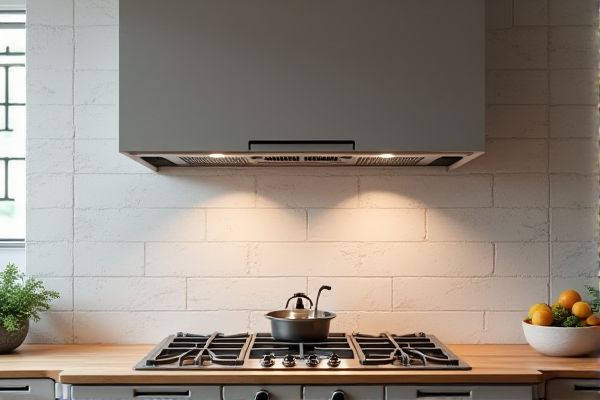
Choosing between a downdraft vent and an overhead hood depends on your kitchen layout and ventilation needs, as downdraft vents are discreet and built into the counter, while overhead hoods provide more powerful extraction suspended above the cooktop. Discover which option best suits your cooking style and space by reading the rest of the article.
Table of Comparison
| Feature | Downdraft Vent | Overhead Hood |
|---|---|---|
| Location | Built into cooktop or countertop, rises when needed | Mounted above the cooking surface |
| Ventilation Efficiency | Moderate; captures smoke and odors at cooktop level | High; effectively removes smoke, steam, and odors upwards |
| Space Utilization | Saves overhead space; suitable for kitchens without space above stove | Requires overhead clearance and space |
| Installation Complexity | More complex; requires integration into countertop and ductwork below | Relatively easier; mounted on wall or ceiling with standard ducting |
| Maintenance | Access can be limited; cleaning filters may be harder | Filters and surfaces are easier to access and clean |
| Noise Level | Generally quieter due to lower fan placement | Can be noisier depending on fan and duct design |
| Cost | Typically more expensive due to custom installation | Available in a range of prices; generally less costly |
Introduction to Kitchen Ventilation Solutions
Downdraft vents are integrated into countertops, pulling smoke and odors downward, making them ideal for open layouts with minimal visual impact. Overhead hoods, mounted above cooktops, provide powerful extraction by capturing rising steam and fumes directly at the source. Both systems enhance indoor air quality but differ in design efficiency and installation requirements, catering to varying kitchen aesthetics and ventilation needs.
What Is a Downdraft Vent?
A downdraft vent is an integrated ventilation system installed directly into the cooktop or countertop that pulls cooking fumes and smoke downward, away from the cooking surface. Unlike traditional overhead hoods, downdraft vents offer a sleek, minimalist design and save overhead space, making them ideal for kitchen islands or open layouts. These vents effectively capture steam and odors at the source, improving air quality without obstructing sightlines or cabinetry.
What Is an Overhead Hood?
An overhead hood is a kitchen ventilation system mounted above the cooktop that captures and removes smoke, steam, and cooking odors through a chimney-like structure. It typically features powerful fans and filters designed to improve air quality by exhausting pollutants outside or recirculating cleaned air. Overhead hoods are preferred for their effective smoke removal and ability to illuminate the cooking area for better visibility.
Key Differences Between Downdraft and Overhead Hoods
Downdraft vents are installed directly behind or within the cooktop and pull smoke and odors downward through vents built into the countertop, making them ideal for kitchen islands or open layouts where an overhead hood might obstruct sight lines. Overhead hoods mount above the stovetop, effectively capturing rising steam, grease, and smoke with stronger airflow, offering superior ventilation for high-heat cooking. Key differences include installation location, airflow direction, and overall effectiveness in smoke containment, with downdraft vents providing a sleek, unobtrusive design while overhead hoods deliver more powerful extraction for heavy-duty cooking.
Installation Requirements: Downdraft Vs. Overhead
Downdraft vents require floor-level installation with ducting that must run beneath the cooktop, demanding extensive sub-counterspace and precise alignment for optimal airflow. Overhead hoods install above the cooking surface, often needing ceiling or wall support structures and straightforward duct routing through walls or ceilings. The overhead hood offers more flexible placement options and generally simpler installation compared to the complex under-counter ventilation system of downdraft vents.
Performance and Efficiency Comparison
Downdraft vents offer targeted smoke and odor extraction directly at the cooktop, enhancing efficiency by minimizing airflow disruption and maintaining a cleaner kitchen environment. Overhead hoods provide broader coverage with powerful suction, effectively removing airborne grease, steam, and heat from larger cooking spaces. While overhead hoods typically deliver superior overall ventilation performance, downdraft vents excel in kitchens prioritizing aesthetics and space-saving design without compromising localized extraction efficiency.
Space and Design Considerations
Downdraft vents save valuable overhead space by integrating ventilation into the cooktop or countertop, making them ideal for minimalist kitchen designs or rooms with low ceilings. Overhead hoods require sufficient clearance and wall or ceiling mounting, which may limit cabinet placement and overall kitchen layout flexibility. Your choice depends on balancing aesthetic preferences with practical space constraints to optimize both functionality and design harmony.
Maintenance and Cleaning Needs
Downdraft vents require less frequent cleaning because they are installed flush with the cooktop, minimizing grease buildup compared to overhead hoods. Overhead hoods capture more airborne grease and smoke but demand more regular maintenance to clean filters and surfaces thoroughly. Your choice impacts how often you'll need to perform deep cleaning to keep your kitchen air quality optimal.
Cost Analysis: Downdraft vs. Overhead Hood
Downdraft vents generally cost less upfront compared to overhead hoods, with prices ranging from $500 to $1,500, depending on features and installation complexity. Overhead hoods typically require higher installation costs due to ductwork and mounting, often totaling between $1,200 and $3,000 or more. Your choice should factor in ongoing maintenance expenses and kitchen layout, as downdraft vents may be less effective in ventilating larger cooking areas, potentially affecting long-term efficiency and costs.
Which Kitchen Ventilation Option Is Best for You?
Downdraft vents excel in sleek kitchen designs, offering discreet airflow by pulling smoke and steam downward, ideal for cooktops without overhead space. Overhead hoods provide powerful ventilation with diverse styles, ensuring effective removal of odors and grease, especially suitable for frequent or intense cooking. Your choice depends on kitchen layout, cooking habits, and aesthetic preferences to optimize air quality and functionality.
 homyna.com
homyna.com